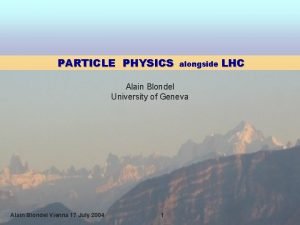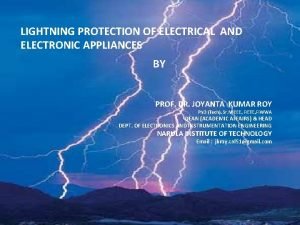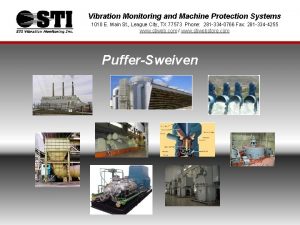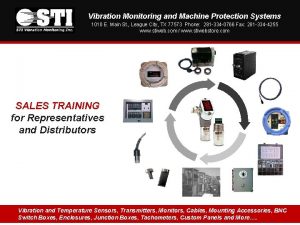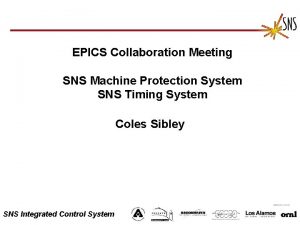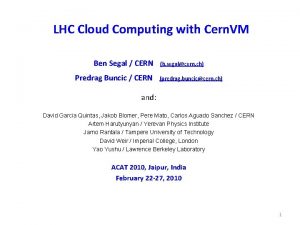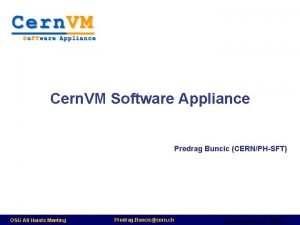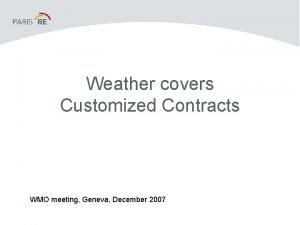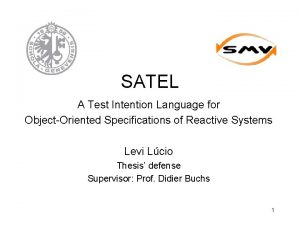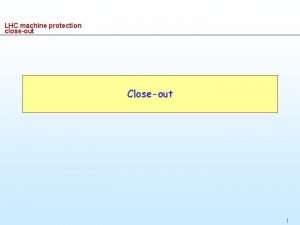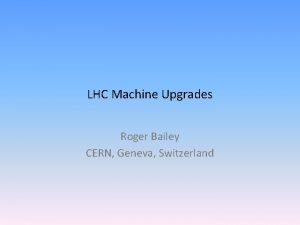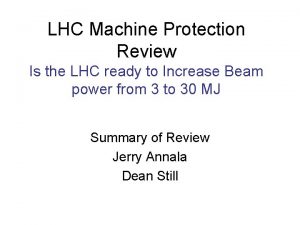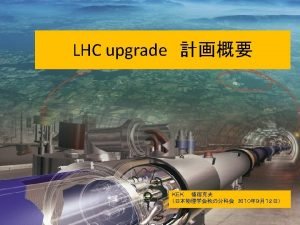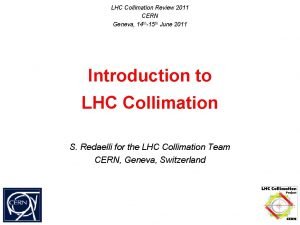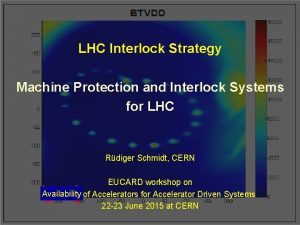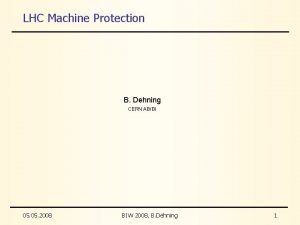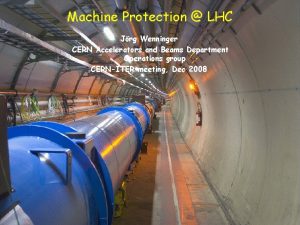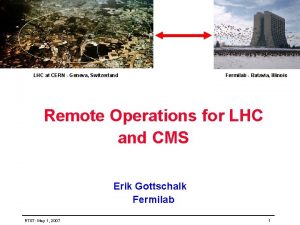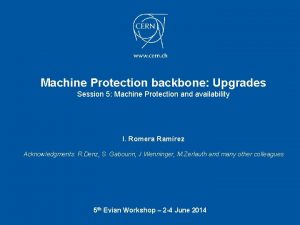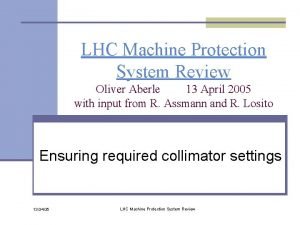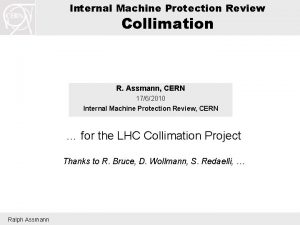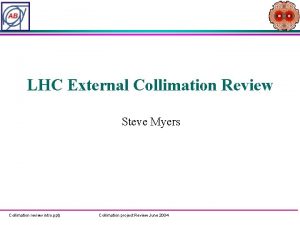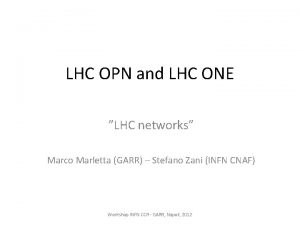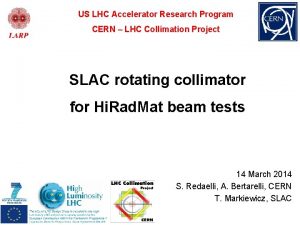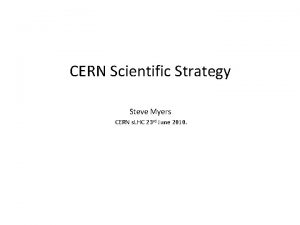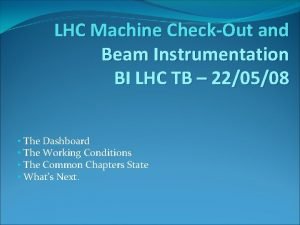External Review on LHC Machine Protection CERN Geneva



















![Collimator gaps [ mm ] Current of Q 5 -L 1 [ A ] Collimator gaps [ mm ] Current of Q 5 -L 1 [ A ]](https://slidetodoc.com/presentation_image_h2/883364fc3b58e835e0e812e1743d31a1/image-20.jpg)
![Collimator jaw position [ mm ] Time-dependent limit functions Dump limits = ± 400 Collimator jaw position [ mm ] Time-dependent limit functions Dump limits = ± 400](https://slidetodoc.com/presentation_image_h2/883364fc3b58e835e0e812e1743d31a1/image-21.jpg)



- Slides: 24

External Review on LHC Machine Protection CERN, Geneva, CH September 6 th-8 th, 2010 Introduction to the LHC collimation system S. Redaelli, BE-OP R. Assmann, R. Bruce, D. Wollmann, BE-ABP for the LHC Collimation team

Outline Introduction Layout and hierarchy Collimator interlocking Collimation operation Conclusions S. Redaelli, MP review, 06 -09 -2010 2

Introduction Eb = 0. 45 → 7 Te. V; Ib = 3. 4 x 1014 Stored energy x 200!! 362 MJ (7 Te. V) 23 MJ (450 Ge. V) Quench limit ~ 10 m. J / cm 3 Damage (metal) ~ 50 k. J / mm 2 Cleaning Protection LHC enters in a new territory for handling ultra-intense beams in a super-conducting environment! S. Redaelli, MP review, 06 -09 -2010 - Control losses 1000 time better than the state-of-the-art! - Need collimation at all machine states: injection, ramp, squeeze, physics - Major role in passive machine protection 3

Layout of Phase I collimation system Two warm cleaning insertions IR 3: Momentum cleaning 1 primary (H) 4 secondary (H, S) 4 shower abs. (H, V) IR 7: Betatron cleaning 3 primary (H, V, S) 11 secondary (H, V, S) 5 shower abs. (H, V) Local cleaning at triplets 8 tertiary (2 per IP) Passive absorbers for warm magnets Physics debris absorbers Transfer lines (13 collimators) Injection and dump protection (10) Total of 108 collimators (100 movable). Two jaws (4 motors) per collimator! Picture by C. Bracco S. Redaelli, MP review, 06 -09 -2010 4

List of acronyms S. Redaelli, MP review, 06 -09 -2010 5

LHC multi-stage collimation Cold aperture Primary collimator Secondary collimators Shower absorbers Tertiary collimators SC Triplet Protection devices Primary beam halo Circulating beam Secondary beam halo + hadronic showers Cleaning insertion Tertiary beam halo + hadronic showers Arc(s) IP Illustrative scheme In all machine phases, the cold aperture must be in the shade of several layer of collimators. Largest losses are concentrated in warm regions! Leakage in cold aperture must be below quench limit (and damage level for warm)! The cold aperture sets the scale for the collimator settings. Different for injection and top energy with squeezed beams (see next slide). Only primary and secondary collimator are robust (Carbon). Absorbers and tertiary collimators (Tungsten) must be protected by the protection devices. Cleaning and passive protection rely on the good hierarchy of collimator families. This is achieved with a beam-based setup of the collimators to centre the jaws around the beam orbit for a given optics (not discussed here). S. Redaelli, MP review, 06 -09 -2010 6

LHC aperture and collimator settings Primary (robust) Absorber (W metal) IP and Triplets ARC Beam halo ➠ Secondary (robust) 8. 5σ ± 7. 5 σ ARC 10. 0σ out ± 8. 5 σ 10. 0σ IP & Triplets 7. 0σ ~30σ ARC 7 Te. V 10. 0σ Beam halo ➠ 6. 0σ S. Redaelli, MP review, 06 -09 -2010 6. 7σ ARC Injection 5. 7σ s e r u ig f d. e t n a o i d t Tertiary Physics absorbers p a r u e e p h (W metal) (Cu metal) o t r V e e at T l 5 e. e 3 s t l l n e wi s e e r W the p for 7

Good setup: hierarchy respected IP 4 IP 5 IP 6 IP 7 IP 8 S. Redaelli, MP review, 06 -09 -2010 cle As TC L Ps TC IP 7 TC SG s TC Ts TC β Du m p an cle p Δp / Ts TC Beam 1 Collimator hierarchy around the ring is verified after setup with dedicated loss maps induced by artificially high loss rates: record beam losses around the ring while crossing betatron resonances. Loss maps compared against simulations to assess system performance. Ts IP 3 an ing IP 2 ing IP 1 Warm betatron cleaning insertion 8

Bad setup: hierarchy violated One TCLA erroneously left in as primary bottleneck after setup Beam 1 Injection protection device for B 1 (IP 2) left IN after end of injection Beam 1 S. Redaelli, MP review, 06 -09 -2010 g n i e n h a t e l c in f e = o g y a e g ch r leak a r a m r. a e s e i d e g h r r e l u d a l l i b a i ( a s f B f ed d pos o s i e m s n o a r a c p ) in e m r o s u r c t r o t e a p a m i l l d l o o c c c i l l a t e m 9

Considerations on hierarchy The collimator hierarchy must always be respected with unsafe beams: - to ensure cleaning (no quenches); - to ensure protection (no damage) Only robust collimators (TCPs, TCSGs) might be exposed to high loss. Collimator settings are given in terms of local beam size and beam position. Once settings are established, the preservation of hierarchy depends critically on: - the mechanical precision of collimator positions →detailed discussion later; - some machine parameters such as orbit and optics. Contrary to other machines, the collimator alignment is done infrequently and we rely on the reproducibility of settings. Dedicated collimator alignment campaigns are done for each machine configuration (injection, he t flat top, squeeze, stable beams) and then we rely on the reproducibility of machine. il in of ta cts e th d pe - Presently using settings established on June 12 (~ 3 months ago) n i s nd a d e t ic rs a f a i e c Consequences of this infrequent setup: tr spe ato e l b ent ollim m. l i - tight constraints on reproducibility of machine parameters! w res s f c yste t o c p e re, → talk n bye. D. s Wollmann. - require regular monitoring of cleaning performance p o i s t e tec a th H f e. o s lks ro immediately ethe n p h Note that if one runs with violated hierarchy risk is not apparent T t ta ine ratio ex an chasynchronous pe but might only show up if there are problemsnlike dump. a o m S. Redaelli, MP review, 06 -09 -2010 10

Outline Introduction Layout and hierarchy Collimator interlocking - Positioning survey - Interlock strategy - MP tests Collimation operation Conclusions S. Redaelli, MP review, 06 -09 -2010 11

Collimator positioning system Two-jaw design: Beam cannot “drift away” if gap under control! R. Assmann Settings: Survey: 4 stepping motors for jaw corners - 1 motor for tank position. 7 direct measurements: 4 corners + 2 gaps + tank 4 resolvers that count motor steps 10 switch statuses (full-in, full-out, anti-collision) Redundancy: motors+resolvers+LVDT’s (Linear Variable Differential Transformer) = 14 position measurements per collimator S. Redaelli, MP review, 06 -09 -2010 12

Position and gap interlocks Energy functions (gaps only) Two regimes: discrete (“actual”) and time-functions (internal clock at 100 Hz ) Inner and outer thresholds as a function of time for each motor axis and gap (24 per collimator). Triggered by timing event (e. g. start of ramp). “Double protection” → BIC loop broken AND jaw stopped Redundancy: maximum allowed gap versus energy (2 per collimator) Additional request to implement beta-squeeze factor for TCT interlocking. S. Redaelli, MP review, 06 -09 -2010 13

Commissioning of MP without beam Example: 1 degree of freedom Summary for 14 limits d e t s m Sequence implemented in the collimator application software: te e t k s c y o l s r e e t t o “Hit” 12 interlock limits (inner+outer for 6 LVDT’s); f e n l i e p h b c m 9 Ea lly, co. 200 ning! “Hit” the 2 limits of maximum gap values versus energy. t a o c i u s O d i s i in input. Monitor on-line: (1) collimator status and (2) status ofincollimator m div nal. BIC m o o c i t a m r Result report automatically generated. ope t of bea star S. Redaelli, MP review, 06 -09 -2010 14

Documentation Specifications Tracking web page on collimation project site http: //lhc-collimation-project. web. cern. ch/lhc-collimation-project/mp-tests. htm MTF maintenance by A. Rossi S. Redaelli, MP review, 06 -09 -2010 15

More on documentation Results of collimator machine protection commissioning linked to from the MPP we page. S. Redaelli, MP review, 06 -09 -2010 16

One problem encountered with beam. . . Outer dump limit Jaw position Inner dump limit Limit functions did not start at the beginning of the ramp Safe limits exceeded here. Dump triggered here. One bug found in the control system: limit functions were zeroed in some cases and did not play the correct ramp profiles. System still safe: beams dumped (but the bug caused a delay of ~3 min in the interlock trigger). This happened twice before we could trace the bug and fix it. S. Redaelli, MP review, 06 -09 -2010 17

Outline Introduction Layout and hierarchy Collimator interlocking Collimation operation - Present run scenario - Performance Conclusions S. Redaelli, MP review, 06 -09 -2010 18

Collimator “relaxed” settings Relaxed configuration are possible with squeezed beams because at 3. 5 Te. V the triplet aperture is larger: 17 sigmas instead than the nominal 8. 5 sigmas → RB’s talk “Relaxed settings”: during ramp, only TCP gap scale like √(energy). Other collimators maintain a constant retraction in mm → allows more margins. This gives more operational margin against the protection device retraction: ~ 5 sigmas! Beam-based settings last established in mid June - stable operation since then. Limit thresholds associated to each set of settings. Smooth transition between different sets, all driven through collimator sequences. S. Redaelli, MP review, 06 -09 -2010 19
![Collimator gaps mm Current of Q 5 L 1 A Collimator gaps [ mm ] Current of Q 5 -L 1 [ A ]](https://slidetodoc.com/presentation_image_h2/883364fc3b58e835e0e812e1743d31a1/image-20.jpg)
Collimator gaps [ mm ] Current of Q 5 -L 1 [ A ] Operation during inj, ramp & squeeze Squeeze 3. 5 Te. V Ramp Stable beams β*=7 m β*=3. 5 m 450 Ge. V TCTs TCSG-IP 6 TCSGs-IP 7 TCP-IP 7 S. Redaelli, MP review, 06 -09 -2010 20
![Collimator jaw position mm Timedependent limit functions Dump limits 400 Collimator jaw position [ mm ] Time-dependent limit functions Dump limits = ± 400](https://slidetodoc.com/presentation_image_h2/883364fc3b58e835e0e812e1743d31a1/image-21.jpg)
Collimator jaw position [ mm ] Time-dependent limit functions Dump limits = ± 400 -500 microns Jaw position during ramp Outer dump limit Inner dump limit Outer warning Inner warning Limit functions (24 per collimator!!) are loaded for all ring collimators. Constant limits remain active also for collimators that do not move (TCTs). Function execution is triggered by the ramp timing event. S. Redaelli, MP review, 06 -09 -2010 21

Gap energy limits It would catch within 2 -4 min after the ramp start (~ 500 -600 Ge. V) if the collimator did not move TCP collimator gap Energy limit = Settings of gap energy maximum allowed gap limit versus beam energy Redundant interlock, independent on trigger: it uses the safe machine parameters. Beam dumped if a collimator does not start moving during the ramp (and sits happily within time-dependent limits). S. Redaelli, MP review, 06 -09 -2010 22

Measured cleaning at 3. 5 Te. V, β*=3. 5 m Beam 1 Betatron Off-momentum 0. 00001 Dump TCTs Legend: Collimators Cold Warm S. Redaelli, MP review, 06 -09 -2010 t n i ils xt e n he ta e d he . . . s k tal 0. 000001 All t 23

Conclusions Introduced the key concepts of the LHC collimation system Most complex build so far: 108 collimators, 400 degrees of freedom; Cleaning needed all the time → Collimators are “ramped” and “squeezed”; Two-jaw design → safer because beams cannot drift away. Reviewed the implemented machine protection features. Highly redundant positioning control. More than 2000 interlock thresholds ensure the correct positioning. More than 500 individually interlocked temperature sensors. All interlocks were tested individually: large amount of work before beam operation payed off to achieve a smooth and safe operation. Reviewed the operation of the system. Present modus operandi: infrequent system setup + reproducible machine. Outstanding performance: no quenches in operation with up to ~3 MJ. Collimation hierarchy needs constant monitoring! More details in the companion talks that follow. . . Details of cleaning performance in the last months of operation; Closer look at the experiments regions (critical: TCT / triplet protection); Various machine protection aspects of the present operation. S. Redaelli, MP review, 06 -09 -2010 24
 Cern geneva
Cern geneva Is 2309 vs iec 62305
Is 2309 vs iec 62305 Machine protection systems
Machine protection systems Cern
Cern Machine protection systems
Machine protection systems Machine protection system
Machine protection system Xxxxvlb
Xxxxvlb Generator overvoltage protection
Generator overvoltage protection Total protection roofing system
Total protection roofing system External-external trips
External-external trips Cern virtual machine
Cern virtual machine Cern virtual machine
Cern virtual machine Microsoft geneva
Microsoft geneva Geneva convention rules of war
Geneva convention rules of war Geneva 304 hac
Geneva 304 hac Shvetsariya
Shvetsariya Chcagi
Chcagi Tuyên ngôn geneva
Tuyên ngôn geneva Bendera palang merah
Bendera palang merah Ethics in ems
Ethics in ems Baptismal ceremony in geneva
Baptismal ceremony in geneva Geneva weather december
Geneva weather december Literacy testdefinition
Literacy testdefinition Wim van lerberghe
Wim van lerberghe Mary o'sullivan geneva
Mary o'sullivan geneva
